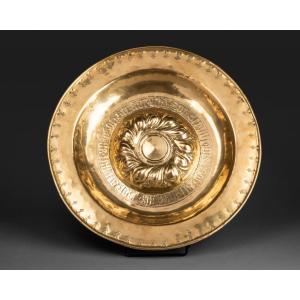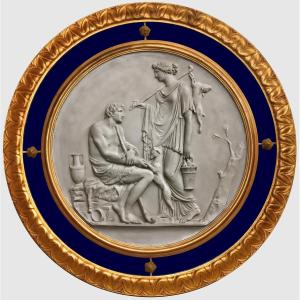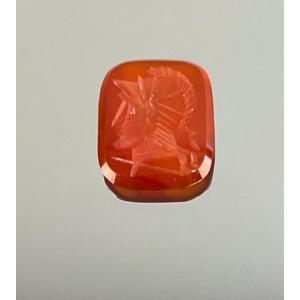This bas-relief depicts a genre scene, that of the grape harvest, performed by five naked children. These little figures share similar physical characteristics and facial expressions: they are all naked, full-figured, with broad heads, wide-set eyes, slightly half-open mouths and short, curly hair.
Some of the children sport a pair of wings, identifying the group as putti, or Amours. Some carry a basket, either at the back or front of their body. Each putti is engaged in his or her task: while one seems to be climbing the tree to pick the highest fruit, or to chase away the pilfering bird, another is stooping to pick it up from the ground, and the last are reaching out with their arms, or a stick, towards the tree.
And while the fruits are identified as bunches of grapes, they are nevertheless shown in a stereotypical round shape. The position of the two tree trunks, straight on the left and serpentine on the right, delimits the composition with clear framing, continued by the bird stretched out at the top, emerging from the thick foliage and disrupting the scene by poking at the fruit the children are trying to gather.
Lastly, we note the presence of trepan traces visible in the putti's hair and in the foliage of the vines.
The Harvesting Lovers are an iconographic type typical of 3rd and 4th century sarcophagi, along with other scenes of harvesting, agricultural work and rural landscapes. While the subject can be found in sarcophagi from these centuries, this work should be seen in relation to the production of sarcophagi from late antiquity, around the 4th rather than the 3rd century.
The Harvesting Bears, which appeared during the era of Trajan (98-117), can be found in the decorations of sarcophagi and mosaics. Although these scenes were initially strongly linked to Dionysiac imagery, their proliferation during the 3rd century removed their Hellenistic and mythological substratum and turned towards the representation of realistic scenes, thus depicting popular life. What's more, the imagery of the Harvesting Bears outlived the Dionysianism of the sarcophagi, taking on Christian parables and enjoying a major revival in popularity between 320 and 360.
The motif of the Harvesting Lovers is an interlude among biblical scenes, and represents the entry of this motif into the decorative system of Christian sarcophagi around the 4th century, such as the sarcophagus from Palazzo Barberini, preserved at Dumbarton Oaks and dating from 330-335.
Present in many sarcophagus decorations at the time, the Harvesting Lovers are loaded with meaning and symbolism. They are found in children's sarcophagi, as in this example preserved in the Louvre, where the harvest scene is coupled with that of treading.
The theme was later taken up again in the decoration of early Christian sarcophagi, such as that of the “Three Shepherds”, dating from the late 4th century and housed in the Vatican's Pius Christian Museum. Here, the three criophoric shepherds are placed on pedestals to punctuate the composition. The scene is populated by Loves, in an impressive horror vacui, who are engaged in various peasant activities such as harvesting the vines, treading the soil, milking the goats, and so on. The sarcophagus was found in the area of a Christian cemetery, and although the decor is inspired by bucolic representations inherited from Roman tradition, its symbolism remains Christian.
Country scenes, and in particular the theme of the Harvesting Lovers, took on a new symbolic meaning when they were revived by early Christian communities. The activities depicted in peasant settings took on new symbolism: the harvest symbolized interrupted life, while the grape harvest and wine-making symbolized the new blood of life in the afterlife. Agricultural themes are a privileged and characteristic feature of early Christian sarcophagi. The scene then finds an echo in the Holy Scriptures, and more particularly in the Apocalypse where an angel comes, at the end of the apocalypse, to harvest the Earth's vineyard (Apocalypse, 14): “And the angel threw his sickle on the earth. And he gathered the vine of the earth, and cast the vintage into the great winepress of the wrath of God. And the winepress was trodden outside the city; and blood came out of the winepress, even to the horses' bits, for a distance of a thousand six hundred furlongs”. The new wine thus heralds the coming of the kingdom of God.
Finally, if the iconography of the Amours has managed to survive in Christian art, it's also because these “winged genii” now belong to the common domain of funerary emblematic art, and form a parable with the apocalyptic figure of the angelic harvester.


















































 Le Magazine de PROANTIC
Le Magazine de PROANTIC TRÉSORS Magazine
TRÉSORS Magazine Rivista Artiquariato
Rivista Artiquariato